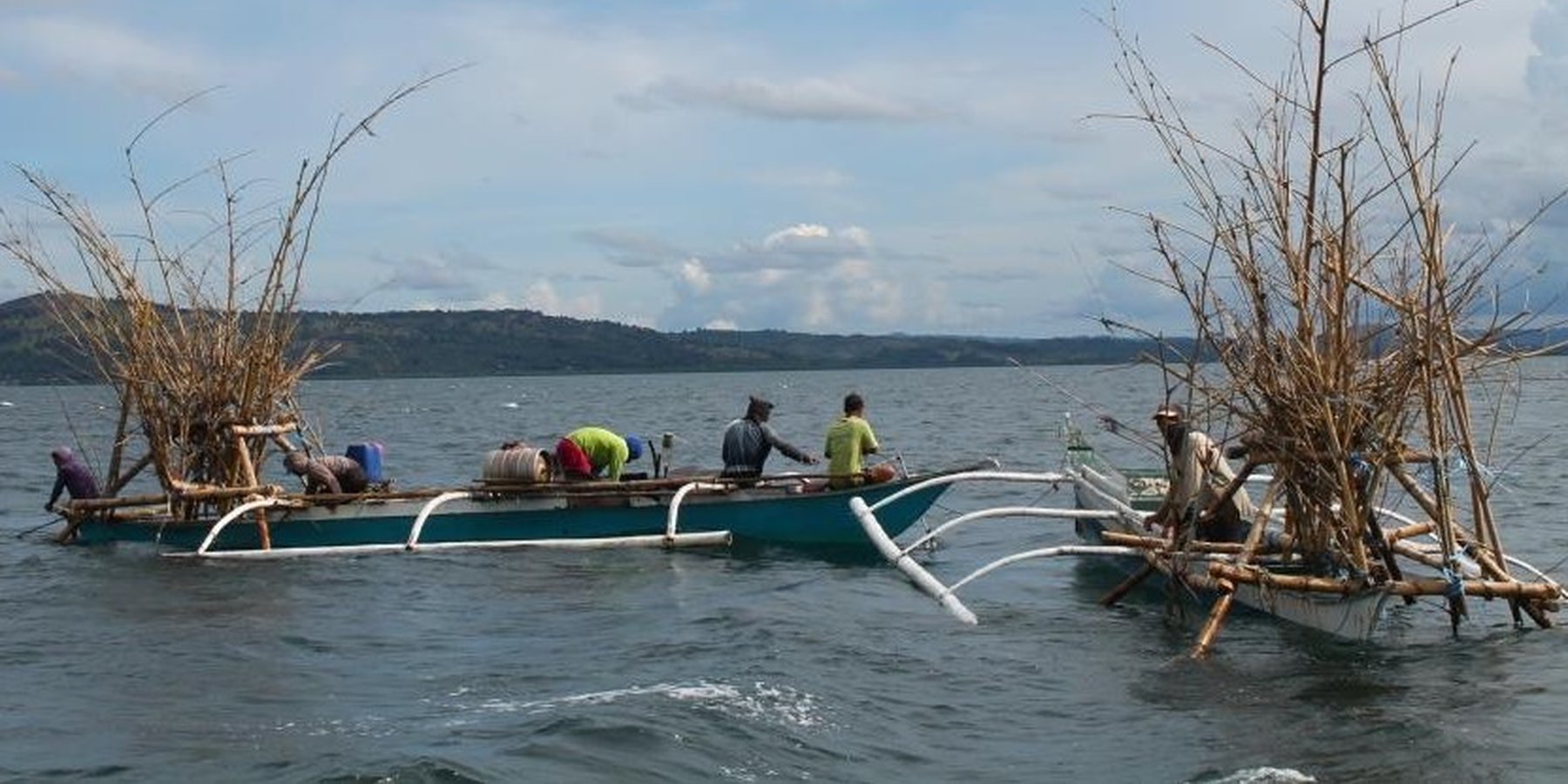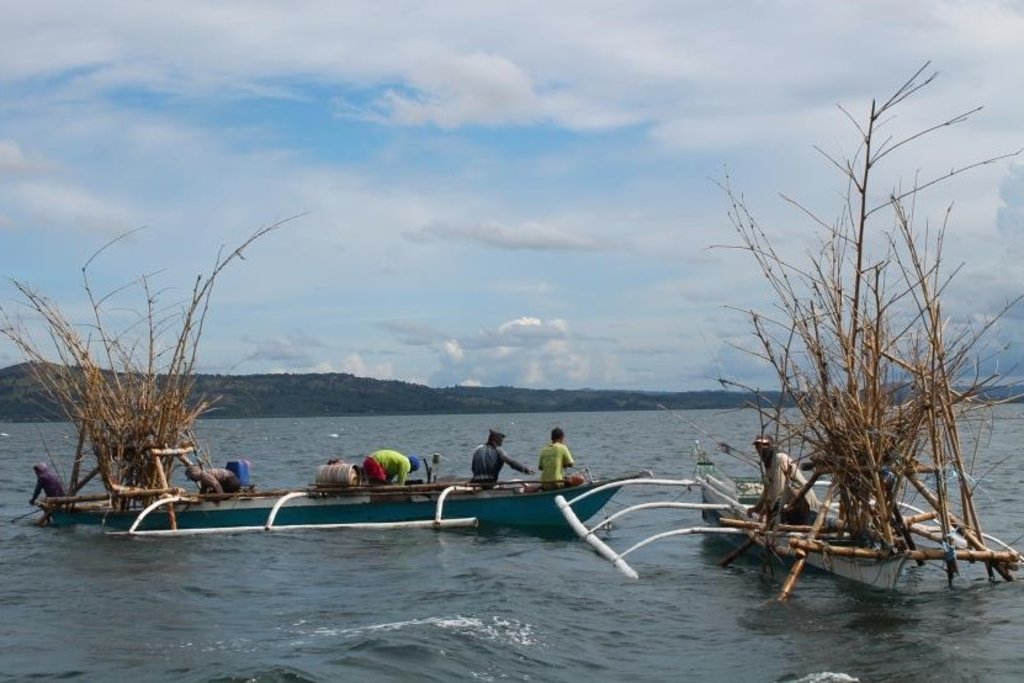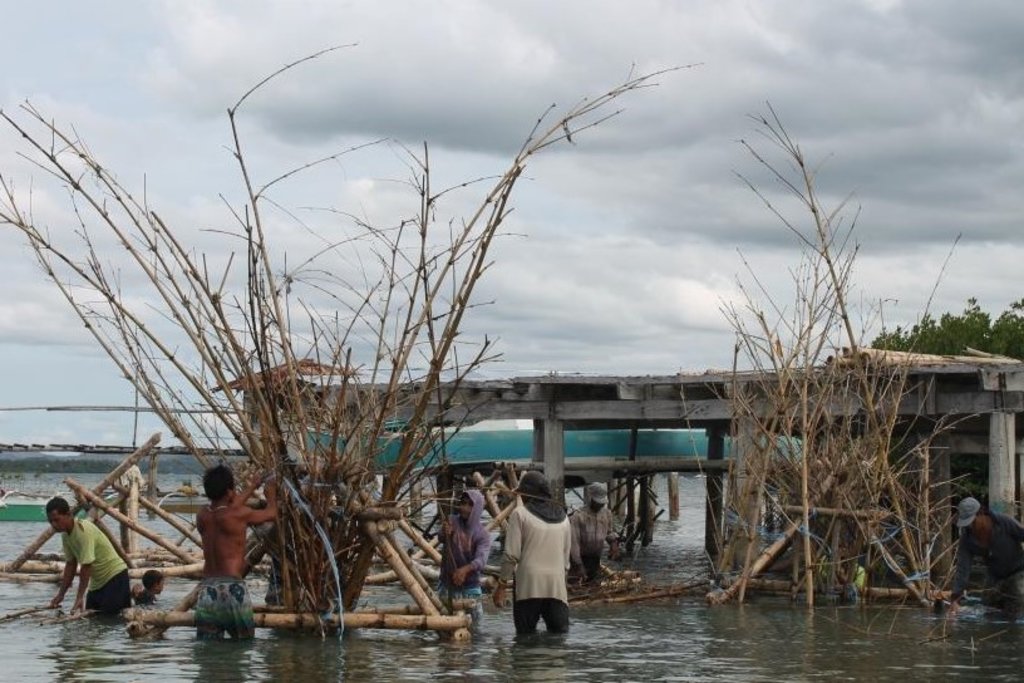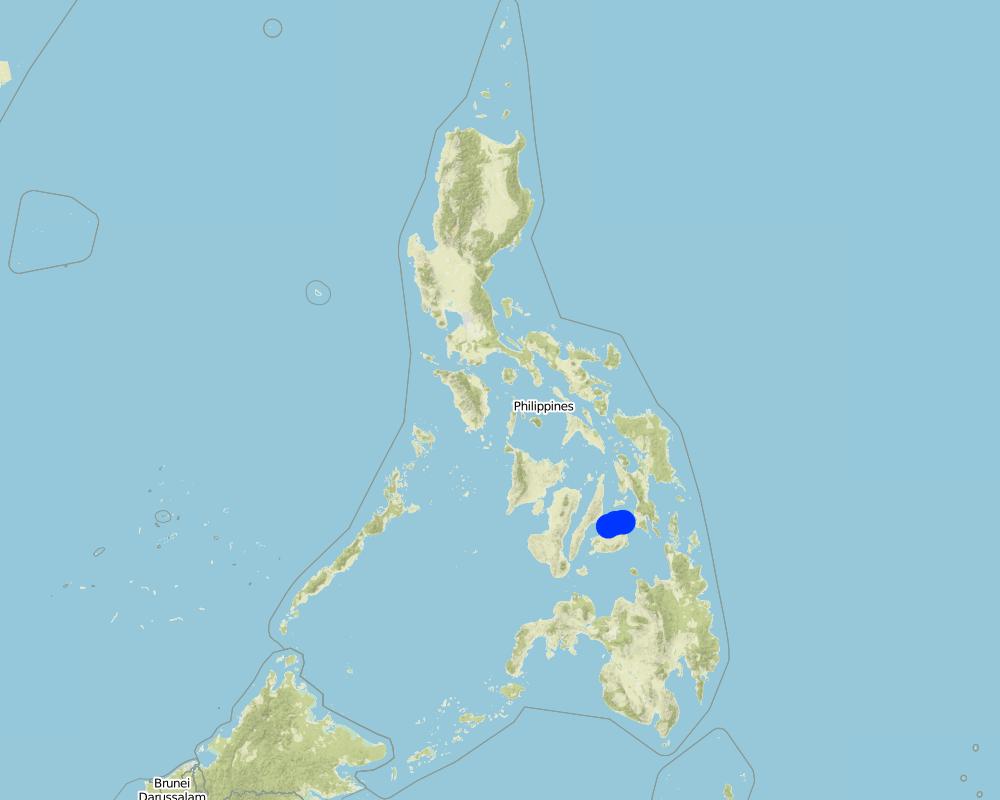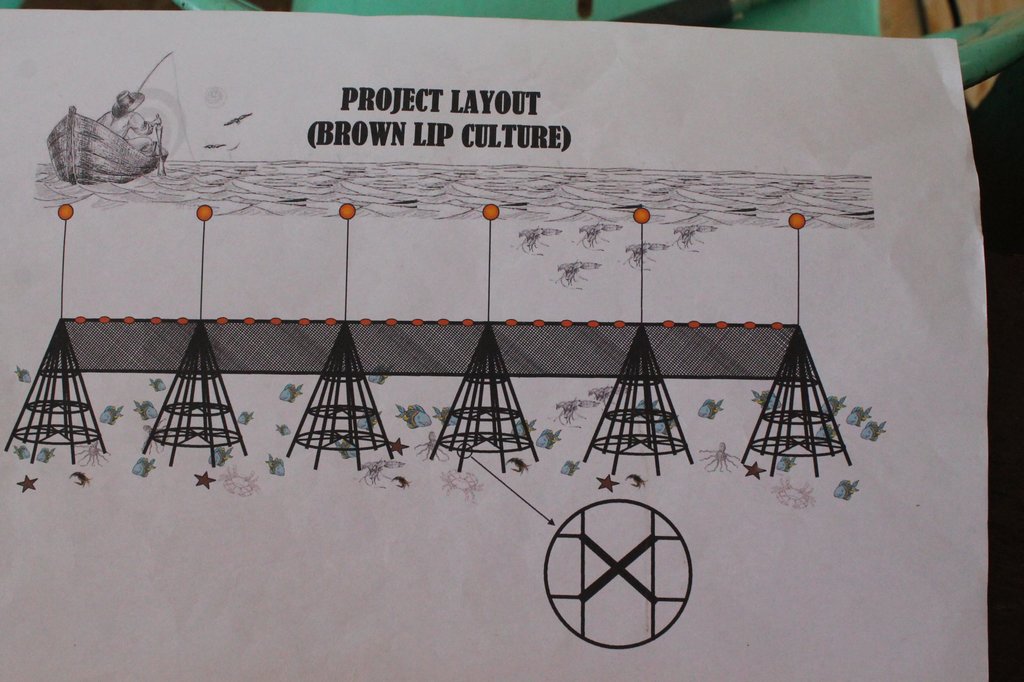Artificial Reef [Philippines]
- Creation:
- Update:
- Compiler: Keeshia Lynn Marie Austria
- Editor: –
- Reviewer: Alexandra Gavilano
Gango
technologies_3116 - Philippines
View sections
Expand all Collapse all1. General information
1.2 Contact details of resource persons and institutions involved in the assessment and documentation of the Technology
Key resource person(s)
Sustainable Livelihood Officer (SLO):
land user:
Name of project which facilitated the documentation/ evaluation of the Technology (if relevant)
Danajon Communities WATCH ( DCW)Name of the institution(s) which facilitated the documentation/ evaluation of the Technology (if relevant)
Philippine Partnership for the Development of Human Resoruces in Rural Areasy (PhilDHRRA) - Philippines1.3 Conditions regarding the use of data documented through WOCAT
When were the data compiled (in the field)?
05/04/2017
The compiler and key resource person(s) accept the conditions regarding the use of data documented through WOCAT:
Yes
1.4 Declaration on sustainability of the described Technology
Is the Technology described here problematic with regard to land degradation, so that it cannot be declared a sustainable land management technology?
No
Comments:
Artificial Reef is installed at the bottom of the sea and anchored in all corners, thus, any weather and climate condition can not directly affect the situation of the technology as an alternative marine habitat.
1.5 Reference to Questionnaire(s) on SLM Approaches

Social Enterprise (SE) [Philippines]
Social Enterprise (SE) aimed to provide social protection among its members and generate additional family income. Above all, this approach will encourage the conservation, preservation and protection of the resources available in the community.
- Compiler: Keeshia Lynn Marie Austria
2. Description of the SLM Technology
2.1 Short description of the Technology
Definition of the Technology:
Artificial Reef is a fish aggregating device that is considered as a sustainable alternative in the islands of Bohol. This technology can withstand the effects of gale warning, typhoons and extreme heat.
2.2 Detailed description of the Technology
Description:
The fishers of Bohol have been using Artificial Reef over a long period of time. This is a fish aggregating device but at the same time, used for brown lip culture. Aside from the above mentioned functions of Artificial Reef, the Island of Bilangbilangan East in Bien Unido, Bohol installed this technology around the buffer zone of the marine sanctuary because the floater will serve as indicator of the marine protected area.
Artificial Reef Technology is a project of Bilangbilangan East Fishers Association (BEFA) from Brgy. Bilangbilangan East, Bien Unido, Bohol; Calituban Fisherfolks Association (CFO) from Brgy. Calituban, Talibon, Bohol and Nasingin Fisherfolks and Mangrove Planters Association (NasFiMPA) from Brgy. Nasingin, Getafe. This technology is owned and managed by the People's Organization found in these three island barangays namely BEFA, CFO and NasFiMPA.
Artificial Reef if is primarily made of bamboo with a life span of 3 to 5 years. For stability, it is anchored in the four corners using a cemented container tied to every end of its corners. For markings, floaters are placed in the sea surface but Nasingin and Calituban fishers preferred not to use floaters for the security of their installed artificial reefs, rather, they used terrestrial points to identify the location.
This technology was installed within the municipal waters (15 kilometers from the shoreline) to help minimize fishing cost and avoid the hazards of sudden change in weather condition. The PO are now vigilant because they already installed Artificial Reefs before but were destroyed by the dynamite fishers. This encouraged the PO members to practice safe and legal forms of fishing in order to sustain their project. Above all, artificial reef will enhance fish spawning and provide alternative shelter to fishes during hot season.
2.3 Photos of the Technology
General remarks regarding photos:
Brown lips will naturally grow in the artificial reef. After 3 months of installation, fishers can already harvest fish while the first harvest of brown lip can be done a year after the installation.
2.4 Videos of the Technology
Comments, short description:
Monitoring of the Artificial Reef in Bilangbilangan Island, Bien Unido, Bohol after 3 months of installation.
A Social Enterprise Project of Danajon Communities WATCH (DCW) Project. Implemented by PhilDHRRA, LPFI and A2D Project. In Partnership with Caritas Switzerland and JTIF.
Date:
01/06/2016
Location:
Brgy. Bilangbilangan East, Bien Unido, Bohol
Name of videographer:
Bilangbilangan East Fisherfolks Association (BEFA)
2.5 Country/ region/ locations where the Technology has been applied and which are covered by this assessment
Country:
Philippines
Region/ State/ Province:
Bohol
Further specification of location:
Brgy. Bilangbilangan East, Municipality of Bien Unido; Brgy. Calituban, Municipality of Talibon; Brgy. Nasingin, Municipality of Getafe
Comments:
The team decided to get the coordinates of the 2 ends and middle part of the Artificial Reef installed due to the weather and current of the tide. Also, these technologies were installed in a linear position.
Map
×2.6 Date of implementation
Indicate year of implementation:
2017
2.7 Introduction of the Technology
Specify how the Technology was introduced:
- as part of a traditional system (> 50 years)
Comments (type of project, etc.):
The 3 areas have tried this kind of method even before DCW Project. However, it was not sustained mainly because of illegal fishing and illegal entry of fishers from the neighboring municipalities and barangays.
3. Classification of the SLM Technology
3.1 Main purpose(s) of the Technology
- improve production
- preserve/ improve biodiversity
- adapt to climate change/ extremes and its impacts
- create beneficial social impact
3.2 Current land use type(s) where the Technology is applied

Waterways, waterbodies, wetlands
- sea
Main products/ services:
Brown lip culture and fish aggregating device
If land use has changed due to the implementation of the Technology, indicate land use before implementation of the Technology:
Before the installation of Artificial Reefs, the fishers are obliged to go beyond the municipal waters which increased their production cost and risk to sudden change of weather.
The Artificial Reef was installed within the municipal waters (15 kilometers from the shore line), fishers will lessen their production cost particularly their fuel consumption. This technology also increased fish spawning and marine conservation.
3.3 Further information about land use
other (e.g. post-flooding):
- not applicable
3.4 SLM group to which the Technology belongs
- improved plant varieties/ animal breeds
- surface water management (spring, river, lakes, sea)
- ecosystem-based disaster risk reduction
3.5 Spread of the Technology
Specify the spread of the Technology:
- applied at specific points/ concentrated on a small area
Comments:
Each Artificial Reef was installed 10 meters apart from each other.
3.6 SLM measures comprising the Technology

structural measures
- S9: Shelters for plants and animals
3.8 Prevention, reduction, or restoration of land degradation
Specify the goal of the Technology with regard to land degradation:
- not applicable
4. Technical specifications, implementation activities, inputs, and costs
4.1 Technical drawing of the Technology
4.2 Technical specifications/ explanations of technical drawing
Materials: bamboo pole, spiny bamboo, nylon #10 and coral stone as sinker
For this project with seed capital worth Php 30,000, 10 Artificial Reefs are targeted to be installed in a linear position.
Artificial Reef is pyramid in shape with the following dimensions:
Height: 12 - 15 feet
Base: 6.6 feet
Installation process:
Interval: 10 meters
Depth: 12 - 15 meters
4.3 General information regarding the calculation of inputs and costs
Specify how costs and inputs were calculated:
- per Technology unit
Specify unit:
Php 3,200 per unit inclusive of installation; Php 32,000 for the 10 Artificial Reefs installed
Specify volume, length, etc. (if relevant):
Length of spread: 90 meters
other/ national currency (specify):
Philippine Peso
Indicate exchange rate from USD to local currency (if relevant): 1 USD =:
51.0
Indicate average wage cost of hired labour per day:
Php 250.00
4.4 Establishment activities
| Activity | Type of measure | Timing | |
|---|---|---|---|
| 1. | canvass of bamboo poles and spiny bamboo | Structural | before construction |
| 2. | purchase of construction materials | Management | before construction |
| 3. | construction of artificial reefs | Management | every 3-5 years |
| 4. | site selection | Management | |
| 5. | installation of artificial reefs | Structural | |
| 6. | monitoring | Management | 3 months after installation; monthly basis afterwards per artificial reef |
| 7. | harvest | Management | 3 months after installation; monthly basis afterwards per artificial reef |
4.5 Costs and inputs needed for establishment
| Specify input | Unit | Quantity | Costs per Unit | Total costs per input | % of costs borne by land users | |
|---|---|---|---|---|---|---|
| Equipment | motorboat rental | piece | 2.0 | 300.0 | 600.0 | |
| Construction material | Bamboo Pole | piece | 10.0 | 120.0 | 1200.0 | |
| Construction material | Spiny Bamboo | piece | 4.0 | 50.0 | 200.0 | |
| Construction material | Nylon #10 | kilo | 10.0 | 120.0 | 1200.0 | |
| Total costs for establishment of the Technology | 3200.0 | |||||
Comments:
No labor cost because the organization agreed that they will do it voluntarily.
4.6 Maintenance/ recurrent activities
| Activity | Type of measure | Timing/ frequency | |
|---|---|---|---|
| 1. | Monitoring | Structural | 3 months after installation, monthly basis after that |
4.7 Costs and inputs needed for maintenance/ recurrent activities (per year)
| Specify input | Unit | Quantity | Costs per Unit | Total costs per input | % of costs borne by land users | |
|---|---|---|---|---|---|---|
| Labour | monitoring | persons-day | 2.0 | 250.0 | 500.0 | |
| Total costs for maintenance of the Technology | 500.0 | |||||
4.8 Most important factors affecting the costs
Describe the most determinate factors affecting the costs:
Supply of bamboo poles and spiny bamboo since they have to find it from the interior part of the mainland.
5. Natural and human environment
5.1 Climate
Annual rainfall
- < 250 mm
- 251-500 mm
- 501-750 mm
- 751-1,000 mm
- 1,001-1,500 mm
- 1,501-2,000 mm
- 2,001-3,000 mm
- 3,001-4,000 mm
- > 4,000 mm
Specify average annual rainfall (if known), in mm:
9999.00
Specifications/ comments on rainfall:
as of 2016 data
Indicate the name of the reference meteorological station considered:
https://weather-and-climate.com
Agro-climatic zone
- humid
5.2 Topography
Slopes on average:
- flat (0-2%)
- gentle (3-5%)
- moderate (6-10%)
- rolling (11-15%)
- hilly (16-30%)
- steep (31-60%)
- very steep (>60%)
Landforms:
- plateau/plains
- ridges
- mountain slopes
- hill slopes
- footslopes
- valley floors
Altitudinal zone:
- 0-100 m a.s.l.
- 101-500 m a.s.l.
- 501-1,000 m a.s.l.
- 1,001-1,500 m a.s.l.
- 1,501-2,000 m a.s.l.
- 2,001-2,500 m a.s.l.
- 2,501-3,000 m a.s.l.
- 3,001-4,000 m a.s.l.
- > 4,000 m a.s.l.
Indicate if the Technology is specifically applied in:
- not relevant
Comments and further specifications on topography:
The technology must be installed along the path.
5.3 Soils
If available, attach full soil description or specify the available information, e.g. soil type, soil PH/ acidity, Cation Exchange Capacity, nitrogen, salinity etc.
Not Applicable
5.4 Water availability and quality
Comments and further specifications on water quality and quantity:
Not Applicable
5.5 Biodiversity
Species diversity:
- high
Habitat diversity:
- medium
5.6 Characteristics of land users applying the Technology
Sedentary or nomadic:
- Sedentary
Market orientation of production system:
- mixed (subsistence/ commercial
Off-farm income:
- less than 10% of all income
Relative level of wealth:
- poor
Individuals or groups:
- groups/ community
Level of mechanization:
- manual work
Gender:
- women
- men
Age of land users:
- middle-aged
- elderly
5.7 Average area of land owned or leased by land users applying the Technology
- < 0.5 ha
- 0.5-1 ha
- 1-2 ha
- 2-5 ha
- 5-15 ha
- 15-50 ha
- 50-100 ha
- 100-500 ha
- 500-1,000 ha
- 1,000-10,000 ha
- > 10,000 ha
Is this considered small-, medium- or large-scale (referring to local context)?
- small-scale
5.8 Land ownership, land use rights, and water use rights
Land ownership:
- group
Land use rights:
- communal (organized)
Water use rights:
- open access (unorganized)
5.9 Access to services and infrastructure
health:
- poor
- moderate
- good
education:
- poor
- moderate
- good
technical assistance:
- poor
- moderate
- good
employment (e.g. off-farm):
- poor
- moderate
- good
markets:
- poor
- moderate
- good
energy:
- poor
- moderate
- good
roads and transport:
- poor
- moderate
- good
drinking water and sanitation:
- poor
- moderate
- good
financial services:
- poor
- moderate
- good
Solid Waste Management:
- poor
- moderate
- good
6. Impacts and concluding statements
6.1 On-site impacts the Technology has shown
Socio-economic impacts
Production
animal production
product diversity
production area
Comments/ specify:
By installing artificial reefs the fishers are not obliged to go further.
Income and costs
expenses on agricultural inputs
Comments/ specify:
decrease in fuel consumption
Socio-cultural impacts
food security/ self-sufficiency
Comments/ specify:
The fishers can catch fish even if there is gale warning.
risk exposure to sudden change of weather conditions
Ecological impacts
Climate and disaster risk reduction
impacts of cyclones, rain storms
Comments/ specify:
The technology will not be affected directly or indirectly by the effects of gale warning and typhoon.
6.2 Off-site impacts the Technology has shown
Comments regarding impact assessment:
Not Applicable
6.3 Exposure and sensitivity of the Technology to gradual climate change and climate-related extremes/ disasters (as perceived by land users)
Gradual climate change
Gradual climate change
| Season | Type of climatic change/ extreme | How does the Technology cope with it? | |
|---|---|---|---|
| annual temperature | increase | very well | |
| seasonal rainfall | wet/ rainy season | decrease | very well |
Climate-related extremes (disasters)
Meteorological disasters
| How does the Technology cope with it? | |
|---|---|
| tropical storm | very well |
| local thunderstorm | very well |
| local windstorm | very well |
Climatological disasters
| How does the Technology cope with it? | |
|---|---|
| drought | very well |
Other climate-related consequences
Other climate-related consequences
| How does the Technology cope with it? | |
|---|---|
| sea level rise | very well |
6.4 Cost-benefit analysis
How do the benefits compare with the establishment costs (from land users’ perspective)?
Short-term returns:
slightly positive
Long-term returns:
very positive
How do the benefits compare with the maintenance/ recurrent costs (from land users' perspective)?
Short-term returns:
positive
Long-term returns:
very positive
6.5 Adoption of the Technology
- more than 50%
If available, quantify (no. of households and/ or area covered):
It's an organizational project with 80 - 120 members each organization.
Of all those who have adopted the Technology, how many have did so spontaneously, i.e. without receiving any material incentives/ payments?
- 10-50%
6.6 Adaptation
Has the Technology been modified recently to adapt to changing conditions?
Yes
If yes, indicate to which changing conditions it was adapted:
- climatic change/ extremes
Specify adaptation of the Technology (design, material/ species, etc.):
Instead of using bamboo poles, one organization decided to cement the poles because it is very difficult to find bamboo in the mainland. Also, bamboo will only last for 2-3 years.
Another organization planned to use plastic straps instead of spiny bamboo so that it will be easier and convenient for them to harvest. Another reason is the availability of brown lip spawn that will stream either at the bottom of the sea, in the middle or along the sea water level. The PO strategize to use plastic straps because they will just hang it above the artificial reef to have better harvest on brown lip.
6.7 Strengths/ advantages/ opportunities of the Technology
| Strengths/ advantages/ opportunities in the land user’s view |
|---|
| According to the management team, the advantage is having alternative site for fishing even if there is gale warning. |
| It will minimize expenses because of lesser fuel consumption. |
| Having an Artificial Reef (AR) project encouraged the members, including their wives to protect the artificial reef site from illegal fishers especially dynamite fishing and trawling. As a result, the people became aware of the effects of illegal fishing and the destruction it will bring to their marine ecosystem. |
| The longer the Artificial Reef (AR) stayed undisturbed, the greater the income. |
| Strengths/ advantages/ opportunities in the compiler’s or other key resource person’s view |
|---|
| Artificial reef enhanced fish spawning, food chain and improved marine ecosystem. |
| Catalyst of behavioral change among the members of the People's Organization namely BEFA, CFO and NasFiMPA. |
| The organization work together for the preservation, protection and conservation of the project site. |
6.8 Weaknesses/ disadvantages/ risks of the Technology and ways of overcoming them
| Weaknesses/ disadvantages/ risks in the land user’s view | How can they be overcome? |
|---|---|
| Monitoring assignment of the members. | Be strict with the Sustainable Enterprise (SE) Management policy. |
| The harvest cost is very expensive because it needs diving gears and large fishing nets. | Collaborate with Bureau of Fisheries and Aquatic Resources (BFAR) for harvest paraphernalia. |
| The organization has no police power to arrest the intruders and illegal fishers that will take advantage. |
Close coordination with the municipal fish wardens (Bantay Dagat). The organization will establish security measures to protect their Artificial Reefs (AR) installed. |
| Weaknesses/ disadvantages/ risks in the compiler’s or other key resource person’s view | How can they be overcome? |
|---|---|
| The duty bearers should implement Philippine Fisheries Code of 1998 (Republic Act No. 8550). | Capacitate the People's Organization to lobby and and implement the law. |
| The local government unit lacks support mechanism for resource-based technologies promoting environment friendly and disaster resilient enterprise. | Partnership among the local government units, people's organization and non-government organizations. |
| Limited exposure to market, business ideas and linkaging. | Conduct Value Chain Analysis (VCA) training, financial coaching, Occupational Safety and Health Standards (OSHS) and on-site mentoring. |
7. References and links
7.1 Methods/ sources of information
- field visits, field surveys
monthly monitoring visits to project sites
- interviews with land users
2 respondent per area
- interviews with SLM specialists/ experts
Sustainable Livelihood Officer
Links and modules
Expand all Collapse allLinks

Social Enterprise (SE) [Philippines]
Social Enterprise (SE) aimed to provide social protection among its members and generate additional family income. Above all, this approach will encourage the conservation, preservation and protection of the resources available in the community.
- Compiler: Keeshia Lynn Marie Austria
Modules
No modules


